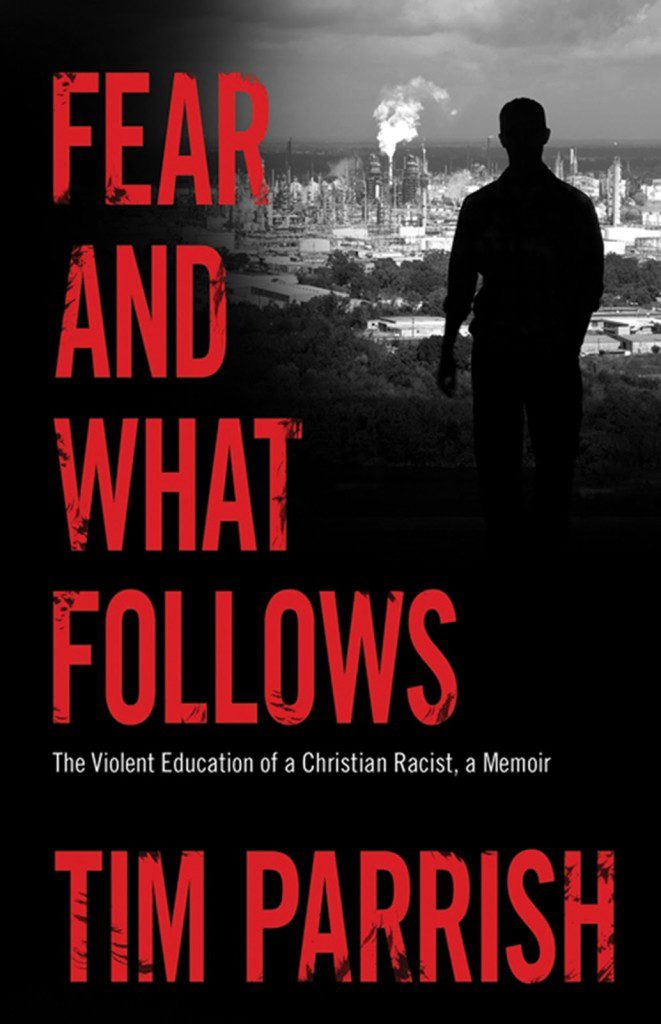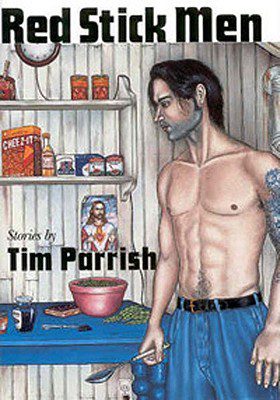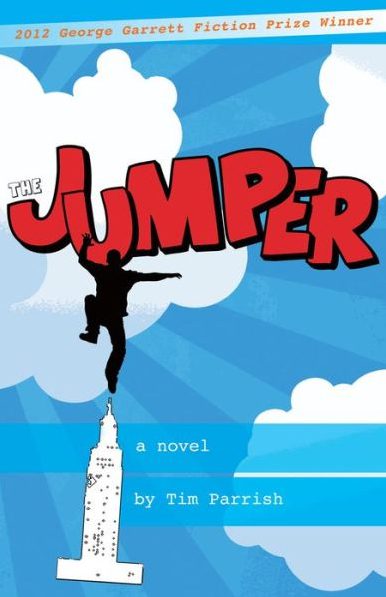
I can’t remember what I was doing the first time I heard Tim Parrish’s name, but I know who said it. Audrey Petty. As Creative Nonfiction Editor of Ninth Letter, she had accepted an essay of his, “Southern Men, 1958-1968,” and suspected I might be interested in it. I was, but I also knew what I was thinking when I heard his name. Tim. Probably from Timothy. What I was thinking was my name could beat up his name any day.
Then I heard Audrey say something about Louisiana, more specifically Baton Rouge, probably because I had told her my parents and youngest sister lived down there for about four years, which included the summer I spent working as an insulator’s helper at the Shell Oil plant that employed my father as a well-paid company man. That night, I discovered Parrish had a collection of short fiction called Red Stick Men. I don’t know what I was looking for in those stories. Best guess is nostalgia for a town I came to love but barely knew. What I got in the opening pages of Parrish’s first book was a working class neighborhood I knew deeply because I’d lived there. Back home in Illinois. What I discovered is that I had Baton Rouge wrong, that Parrish, who had never been to my river town, had it right, and that, holy shit, his father also worked at refineries on the Mississippi. I got his e-mail address from Audrey and wrote him a fan letter.
Thus began an e-mail friendship born of immediate recognition. Two refinery mutts, one Southern, one Northern, get some education and write their way out of the places they’ll never leave, no matter how far away they move. Two working-class white guys write about race, one of them because he thinks he should; the other, Tim Parrish, Red Stick, Southern Man, because he must, because we need him to. We need the word he brings in Fear and What Follows: The Violent Education of a Christian Racist, A Memoir, as brave and chilling a confession and Bible lesson as you’ll read this year or next decade probably. I bend a knee to my younger, wiser brother, tip my refinery hard hat across these Similar States of America.
Tim and I conducted this interview via e-mail.
***
The Rumpus: Before we get to the memoir and Baton Rouge, I have to ask: now that I’m a fanboy of yours, I’ve been having this recurring nightmare. I order a life-size poster of you, one of those Fathead wall decals, and I can’t find an indoor wall tall enough for it. Who’s taller? You or Howard Stern? I know who’s smarter.
Tim Parrish: Why is that a nightmare? To your question, though, Stern might be taller, but I have prettier hair.
Rumpus: Fear and What Follows: The Violent Education of a Christian Racist is about your descent into racism and then your escape from it. Could you talk a little about that experience?
 Parrish: Sure. I mean, the title really does sum up the part about my spiral into racist violence and my escape. My world got destabilized by a number of things when I was about twelve. I got physically attacked, became terrified, and wrongly believed that allying myself with a brute and attacking an “other” would make me safe. It’s exactly what I saw happen to America after 9/11. We got scared and we went after a country that had absolutely nothing to do with the reason we were scared. And it was easier to go after them because they were dark-skinned Muslims. When all that happened, the feelings I had as a teenager came up full-blown in me again, and I knew I had to write about them, since I felt as though I had some experience with those feelings and perhaps some perspective.
Parrish: Sure. I mean, the title really does sum up the part about my spiral into racist violence and my escape. My world got destabilized by a number of things when I was about twelve. I got physically attacked, became terrified, and wrongly believed that allying myself with a brute and attacking an “other” would make me safe. It’s exactly what I saw happen to America after 9/11. We got scared and we went after a country that had absolutely nothing to do with the reason we were scared. And it was easier to go after them because they were dark-skinned Muslims. When all that happened, the feelings I had as a teenager came up full-blown in me again, and I knew I had to write about them, since I felt as though I had some experience with those feelings and perhaps some perspective.
Luckily for me, some people, both black and white, stepped in when they saw how far things had gone for me. Some really transcended their own beliefs in doing this, and some courageously risked racist backlash for doing it. I was in deep, and these people were willing to jump in and save me. I’m endlessly thankful to them.
Rumpus: Fear and What Follows is many things—Southern history, white working-class memoir, race confession—but it’s also a story of masculinity, the record of a son and youngest brother struggling to become a man in the long shadows of strong males. It’s a wonder you’re here.
Parrish: I guess surviving circumstances is all relative. Also literally relative, pardon the joke. I mean, compared to my daddy and middle brother, who respectively went to Nagasaki three weeks after the bomb and Vietnam during the war, my escape to a less violent life and a saner way of living seems like busting through tissue paper, although I certainly was in danger a number of times of being badly hurt or killed, or doing those things to some black kid. I’m sure my seeing my father and older brothers as strong men in their macho and highly-dramatic behavior made me feel I had to act out large to live up. Foolish, but nobody told me differently until I was deep into racist, violent shit.
Rumpus: The reality you convey is always powerful and, to this son of a refinery town, immediately recognizable. Halfway through the first story in your story collection, Red Stick Men, I was at home. Your gritty Baton Rouge neighborhood was, minus the moving-in of black folks, my Illinois canal town, Hartford. Fear and What Follows returns me to that same neighborhood, the place where you learned how to be a man. Tell me some more about the lessons in manhood you received there.
Parrish: Primarily, that being a “man” meant being physically stalwart and emotionally restricted. I believed it was acceptable to express rage, humor, or contempt but little else. That set me up for a lot of disappointment and even despair after I was in a life-threatening street fight at thirteen, and then afterward was stalked by an older sociopath. I felt completely helpless and unable to talk about what was happening. Even my tough cop brother couldn’t help me. And since I also believed it was a man’s duty to “protect” what was ours—although what was “ours” wasn’t completely clear beyond our house and neighborhood—I felt cowardly and useless.
To try and get any sense of masculine self back, I convinced myself that I would be safe and manly by following a manipulative, badass racist named Dyer into all sorts of insane, dangerous, despicable activities, which of course made everything worse. And when you throw in the backdrop of being brought up in a Southern Baptist church that was simultaneously teaching me to love Jesus and to be intolerant, I had no idea what the lessons were supposed to be.
Rumpus: In the drafting of the book, how hard was it to meet up with the white boys, Jarreau and Lassiter, who attacked and stalked you?
Parrish: I’m assuming you mean meeting up with them figuratively since I’m pretty sure Jarreau is dead or in prison, and Lassiter, quite likely the same.
It was surprisingly horrific, especially considering that the events which include them took place between 1972 and 1975. The shame and anger were still unbelievably toxic. Toward Lassiter, the kid I had the terrible, life-threatening fight with when I was thirteen—the fight that really started me down the road to feeling true terror—I felt a lot of anger and, at first, the wish for revenge. I wanted to go back in time and hurt him badly, wanted to go back and fight him over and over, until I came out decidedly on top rather than in a kind of draw. I flat-out wanted to kill Jarreau, the sociopath who started stalking me after the fight with Lassiter, and who truly terrorized me.
The welling up of shame and the acute feeling of being a coward were nearly overwhelming. I was bowled over by how much I hadn’t come to terms with those feelings at all, and when they rose up, so did the intense powerlessness I felt way back then. I mean, I thought I was beyond an impulse to actually want to kill somebody, particularly somebody I knew was pathetic and whose life had already self-destructed before I was even out of high school. I can’t say I truly forgave them, or myself for being a “coward” because I didn’t fight them over and over, but I think I’ve managed to see them as the damaged, most-likely-abused boys that they were.
The shame I felt around them was nowhere close to the shame I felt about my later racist behavior, though.
Rumpus: What about Dyer?
Parrish: Encountering Dyer, my supposed savior from terror, was much more complicated because, even though he took me in, guided me, and then bullied me toward being a true, virulent racist, I loved him as a brother in some ways. I also saw again—as I saw then but couldn’t completely hold onto—that he was scared of losing everything he had, because he felt as though his family’s neighborhood had been taken from him by blacks. This might sound strange, but I’m thankful that he was also responsible for turning me onto drugs, partying, and a lot of great music, part of which was dangerous, but a lot of which was fun, too.
The most complicated realization I had, I suppose, is that without him and his poisonous confrontation and coaxing, I may not have fully discovered my better self, and I certainly wouldn’t have looked all my demons so forthrightly in the eyes. Don’t get me wrong. I was angry at him, too, but I think I had compassion for him from the get-go because I knew that, in his warped way, he did care about me and he thought he was trying to make me a man by making me somebody who could take care of myself through violence. And I figured out that he was also, in part, a sociopath. Knew that the range of what he could feel had been shut down, whether by him or circumstances or genetics, I don’t know. In any event, I do feel like I ended up forgiving him for what he did, probably more than I ended up forgiving myself for some things I did.

Rumpus: My introduction to your writing came via Red Stick Men. I love those stories. In what way did they set the stage for Fear and What Follows and your new novel, The Jumper, which also deals with racism?
Parrish: The stories in Red Stick Men came from my discovering that it was legitimate for me to write about working-class people and their (and my) experiences in and around Baton Rouge. I’d taken stabs at some autobiographical material way before the stories for that collection, but the Red Stick Men stories are where I discovered that everything I needed as a writer—really, everything universal—was right there in Red Stick, particularly the complicated lives of hard-working, often-racist, morally-struggling people living in an unpredictable and volatile environment. I also realized, while working on those stories, how the nightly burning sky from the refineries and chemical plants, which I could see and smell from my bed as a kid, made me feel like I was living on the edge of the apocalypse, just like I heard at church every Sunday. Part of that perceived apocalypse was the “encroachment” of black people, who were coming from the direction of those fires. Those stories were my gateway into thinking hard about how racism and the fear of blacks were the backdrops for nearly everything we thought.
Rumpus: Let’s talk about that a bit more. How do you see race playing out in those stories?
Parrish: In the stories about adolescence, set circa early ‘70s, racism gets expressed among whites rather than directly to black people, because those white characters, like me at that time, don’t interact with black people much. In one story, a white cop in the neighborhood beats up his wife and blames it on a black intruder, and the neighborhood is willing to go along with that lie to stay comfortable. In other stories set later, racism comes out in reactions to Iraqis during Desert Storm and in casual statements as part of the daily fabric. It’s such a constant that almost no one questions it.
Rumpus: I ask because a white writer will often create a neighborhood, a world even, without black folks in it. Here in America, which is anything but post-racial, race is the issue and has been for some time. Why are representations of blacks conspicuously absent in so many stories by white writers?
Parrish: Let me start by saying that I believe white writers, on the whole, have not looked at racism very deeply. That said, I think that black characters are often absent in work by white writers because America is still astonishingly segregated. To a lesser degree, I think some white writers are nervous about portraying black characters. I know when I was in grad school in the ‘80s, a hot political issue was the appropriation by white writers of African American characters and experience. The most extreme view was that white, male writers shouldn’t write African American characters at all because doing that was a kind of colonization of the African American experience. Madison Smartt Bell had a great response to this, which was basically, if I recall correctly, that if we disallow our imaginations from going anywhere we want, we risk not understanding anybody outside ourselves and that makes art strictly a narcissistic exercise.
I once asked John Wideman what he thought about whites writing black characters, and he said, “Try it, and if somebody thinks you got it wrong, they can tell you.”
Rumpus: What’s at stake for the white writer who dares to include them?
Parrish: I’m not sure there’s a lot “at stake” for the white writer. I think different white writers feel different challenges, as you know from your work dealing with racism. Me, I’m most wary of using a black character as representative rather than fully developing him or her. Of course, I’m also wary of that when I’m writing any character, but with African American characters, the bar to avoid any stereotype is much higher because attentive people are rightly hypersensitive to the political baggage attached to stereotyping African Americans.
I guess something that might be called “at stake” is a white writer being called racist for portraying a black character in a particular way, but I think that risk is worth taking in order to try and portray a world that’s realistically complex in terms of race. The biggest challenge to me is to not perpetuate stereotypes, which happens if a white writer uses black characters only as victims to be saved, for instance, from “rednecks” by the educated, white liberal, as in To Kill a Mockingbird, or as other flat devices. I’ll add that some of the same challenge—although without the tragedy of slavery and Jim Crow—applies when a writer stereotypes racists, especially poor or working-class racists. In both of those cases, it’s just lazy writing and a way to appeal to comfortable preconceptions.
Rumpus: Would you speak to the seeming necessity of violence in our lives and its specific applications in Fear and What Follows? Did the writing of Fear and What Follows teach you anything about violence that you didn’t already know?
Parrish: Writing this book definitely taught me how much emotional and psychic violence I still had in me, and I hope that I have less now because of writing the book. I certainly manage it better, and I’m sorry that I didn’t manage it better while I was writing this book. I was furious at the Bush administration and at my country for invading Iraq and for turning away from New Orleans during and after Katrina and, frankly, at how the big-house publishing industry wanted nothing to do with my book, even though readers I trust and respect were telling me the book was timely and was pointing out important things. I inflicted a lot of fear on some people around me by being out of control and by just being frighteningly depressed. I didn’t see myself as being a scary person, because I still saw myself as a scared person, but I was scary. So, coming to terms with some of the violence in myself was life-changing.
As for the “necessity of violence in our lives,” that’s a question that’s hard to wrap my head around. I think there’s little necessity for violence, and certainly not to the extent our masculine society seems to believe is necessary. Personally, I think the only necessity for violence is to protect people we love, and ourselves, from imminent harm, and then only as a last resort. And the rationale for even that violence is circumstantial and complex. For example, I ran into a burglar in my living room in New Haven once and was able to negotiate getting him out of the house without anybody getting hurt. If I’d had a gun—which the cops scolded me for not having when they got there—somebody would’ve gotten shot. And that wouldn’t have served anybody well. In terms of the necessity for violence as a nation, it seems obvious that our nation is far too quick to go that route, and far too sanguine about justifying it in, for instance, our ready use of drones. Talk about terror. Can you imagine living your life with a buzzing airplane over your head all the time and just wondering if you were going to be blown up because somebody America wanted dead was in your neighborhood?
Rumpus: How was writing memoir different from writing fiction? What was the process of writing Fear and What Follows?
 Parrish: I guess some of this answer is also obvious because I’m evidently a pretty obvious person. First, I was constantly dredging up emotions and moral conflicts that I had to confront and reckon with. That happens while writing fiction, but it’s not all attached directly to me and my history. Second, I was having to write within the strictures of a “factual” time-line and be aware that I was representing, at least in part, real people, even if they’re composites. I didn’t have the complete license of a fiction writer in arranging events or using other characters’ points-of-view (or I felt I didn’t, because I was writing a conventional memoir), and sometimes it seemed nearly impossible to convey what I thought would be a more comprehensive understanding of what was going on. Third, I had to figure out the balance between analysis of events and my strong suit, which is dramatization. Along with this, I guess, was a decision about tone, which I chose to be as straightforward and un-ironic as possible. I was also constantly aware, and still am, of the ethics of telling other people’s stories accurately and not exploiting them, an issue that’s infinitely complicated. Finally, and this was something I stupidly didn’t anticipate, was having to create myself as a character within the narrative, meaning create a representation of myself that was accurate although not comprehensive. I mean, I couldn’t cover all of who I understood myself to be, and so focused on the elements of myself that revealed the through lines of the story and held together tonally.
Parrish: I guess some of this answer is also obvious because I’m evidently a pretty obvious person. First, I was constantly dredging up emotions and moral conflicts that I had to confront and reckon with. That happens while writing fiction, but it’s not all attached directly to me and my history. Second, I was having to write within the strictures of a “factual” time-line and be aware that I was representing, at least in part, real people, even if they’re composites. I didn’t have the complete license of a fiction writer in arranging events or using other characters’ points-of-view (or I felt I didn’t, because I was writing a conventional memoir), and sometimes it seemed nearly impossible to convey what I thought would be a more comprehensive understanding of what was going on. Third, I had to figure out the balance between analysis of events and my strong suit, which is dramatization. Along with this, I guess, was a decision about tone, which I chose to be as straightforward and un-ironic as possible. I was also constantly aware, and still am, of the ethics of telling other people’s stories accurately and not exploiting them, an issue that’s infinitely complicated. Finally, and this was something I stupidly didn’t anticipate, was having to create myself as a character within the narrative, meaning create a representation of myself that was accurate although not comprehensive. I mean, I couldn’t cover all of who I understood myself to be, and so focused on the elements of myself that revealed the through lines of the story and held together tonally.
And all of this was highlighted because at that time, I was heavily revising my novel, The Jumper, which also deals with race, and making huge changes in the structure, points-of-view, and characters. I’m not sure I ever want to write longform memoir again, I can tell you that.
Rumpus: You’re a good man, Red Stick, both in spite of and because of yourself. Thanks for talking to me.
Parrish: Back at you, brother!




